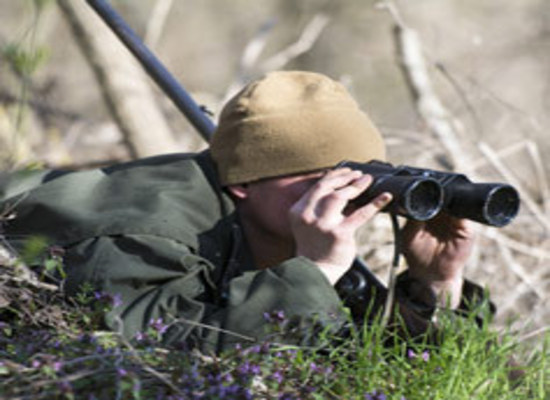This article is the first in a series that covers hardening your home and some easy, low-budget alternatives for early-warning systems and fortifications. For all the prior service members (especially 11-Bravos), parts of this will be basic: this info is especially for those who haven’t been in the military to introduce them to some fundamentals. Please bear with me and do not feel insulted.
We need to define a few terms that I hope you’ll come to use: cover, concealment, and camouflage.
Cover provides you with just that: a certain amount of protection (depending on materials used) from small-arms fire up to the dam-dam (artillery). Cover places that material between you and the aggressor to protect you from bullets, spears, etc. Examples are walls, foxholes with sandbags, or log piles.
Concealment, on the other hand, shields you from view, but doesn’t necessarily provide you with physical protection from attackers. Examples here are thick hedges, bushes, or screens (such as for a duck blind). You can have both: a sandbagged fighting position (FP) with a hedge having its top running the length of the front parapet and slightly above it, obscuring the FP from view. The hedge could also serve as camouflage of its own physical merit.
Camouflage is the art of blending men or materials with the surroundings: a disguise. The camouflage should be dictated by season, terrain, climate, and whether an urban or rural environment. Obviously if you’re in downtown Chicago, you may be noticed wearing BDU’s and a drive-on rag, camo’d up and bedecked with small cut tree branches akin to the Swamp Thing. You may also wish to reconsider walking around as a one-man forest with artificial leaves in the dead of winter. The object is to blend into your surroundings as called upon by the moment/time of the year.
All three factors can complement and mutually support one another: a protective masonry retaining wall (cover) behind some thick bushes (concealment) with happy flowerbeds in between the bushes (Better Homes and Gardens Suburban Camouflage). You’ll have to take time to carefully spec out what features your property has and what you’ll need to add or detract. Remember this rule: do not permit your attacker to be able to use the FP against you in such fashion.
Now let’s cover windows. Tiny Tim may wish to tiptoe through the window with a Molotov. You can put a stop to this by covering the exterior of the windows with wire mesh. I strongly recommend 2”x 3” rectangular wire-mesh/re-wire; either galvanized or coated, the heavier the gauge the better. The wire doesn’t obscure any view and can accommodate your muzzle for a firing port (on movable windows that open). The wire will help deflect rocks, grenades, and Molotov’s, the latter, I must say from experience being very bad. A marauder can throw a log through it to pave the way for the Molotov, but the wire can buy you the time to deal with him first.
Wire that doesn’t match your house can be painted with all-weather paint for metal using a brush or roller. You can pre-measure your pieces and then attach them to the casing or the house with those U-shaped nails that electricians use. The more the merrier, at the farthest edges all around to negate a pry-bar. I strongly recommend this way, as screws can be unscrewed. Very important: make sure there’s space between the window and the wire, to allow some give for the marauder’s projectile. You may have to build it up on all sides with 2”x 4”’s to provide that space, but it beats a barbeque.
Walk your property. Note down and commit to memory every critical distance and feature: front door to front gate, length and breadth of ground, dead space, and possible places for attacker cover and concealment. Have your whole family participate and make it a group endeavor, taking special care to teach the kids the “why” part. Assign each family member/cohabitant an area of responsibility to defend. The Eighty-Deuce [I was in B Co. 2nd BN, 504th PIR (ABN) before I went SF] was great with repetition. Our First Sergeant’s favorite sayings were “Repetition promotes a good follow-through,” and “How you train is how you’ll fight.” Sound and true advice.
Training and emergency drills for your family will cut down on the confusion should anything occur; repetition could be the deciding, winning factor for your family’s engagement. I also highly recommend Motorola’s, one for each family member. Teach them good commo and radio discipline and how to keep it short and sweet (KISS principle in effect). Vox’s free your hands but they don’t have great range and solid objects such as walls can interfere with them. Motorola’s are simple. Keep it simple.
 If you’re in an area and State that you can do it, fence off your property and put a securable gate on it. The fence can be supported/strengthened by blending natural and man-made defenses that will prevent or slow vehicles from entering a point other than the gate. The gate is exactly where I want them. Channel your attacker. Funnel him into the areas he will be vulnerable to you. Make sure to post signs inside of your fence about 10′ back and visible everywhere: No Trespassing/Keep Out/Private Property.
If you’re in an area and State that you can do it, fence off your property and put a securable gate on it. The fence can be supported/strengthened by blending natural and man-made defenses that will prevent or slow vehicles from entering a point other than the gate. The gate is exactly where I want them. Channel your attacker. Funnel him into the areas he will be vulnerable to you. Make sure to post signs inside of your fence about 10′ back and visible everywhere: No Trespassing/Keep Out/Private Property.
If you can swing it, run the aforementioned rewire all around the fence on the outside (if it’s split-rail and post). Cut stumps with their roots still attached make excellent “buffers” for the outside of your fence. Space these about 10′ outward. When snowfall comes, they won’t be able to be used as “Evel Knievel” ramps.
With electronic sensors and surveillance you’ll have to tailor your system to fit your needs also taking budget, geographic location, and climate into account. Here in Montana IR sensors aren’t too effective with steady temperatures of -20º F, not to mention if an EMP ever occurs. If you have such a system, I recommend hooking them to an internal chime in your bedroom and not into lights. If the intruder enters the property, the lights will let him know you’re alerted and light his way for him. He’s already trespassing on posted property with dubious intentions; hopefully the “Castle Doctrine” applies to your state. Better to localize him to the sensor he tripped, alert your family quietly, grab your NVG’s, and deal with him.
I’m sure many of you have my mindset: preferring the Lensatic Tritium compass to the GPS-gadget.
Here’s a low-budget “Uncle Caveman” alert system for you: 15-20lb-test nylon line, eye hooks, and cup hooks for a tripwire perimeter. Secure one end stationary, and the free-running end tie to a bunch of aluminum cans with pebbles in them. You can cover the whole perimeter of the house. Just make sure you shield the cans from moisture and wind as much as possible. Know where they are: you should practice walking around your house in the dark and knowing by feel how to avoid tripping them.
Mirror, mirror, on the wall: show those trolls who crouch and crawl! Mirrors (4” to 6” round or square, convex are preferable) can be positioned on the corners of your porch and outside your windows. You can also set long dressing-type mirrors outward from the corners of your home. Is Tiny Tim squatting next to that front porch wall, with a baseball bat? The mirror can show you. Remember, they’re light dependent, and they also work both ways. You must practice with them and train your eyes to use them regularly so that it becomes habitual.
Remember with all of this, training for each and every member of your household is vital; with this training will come good feelings of confidence that will help quell fear and panic if an emergency arises. It is good to train as a team. Success brings family bonding and will help each of you develop confidence in one another, as well. May it never have to be put into action, I wish for you. In the next article we’ll cover tactics and defenses in depth for the home, and go deeper into the fortifications. Finally (CYA-policy), be sure to check out all laws and regulations prior to taking any actions or utilizing the information in this article. Have a great day!
Jeremiah Johnson is a retired Green Beret of the United States Army Special Forces (Airborne) and a graduate of the U.S. Army’s SERE school (Survival Evasion Resistance Escape).
Source:: ShtfPlan





